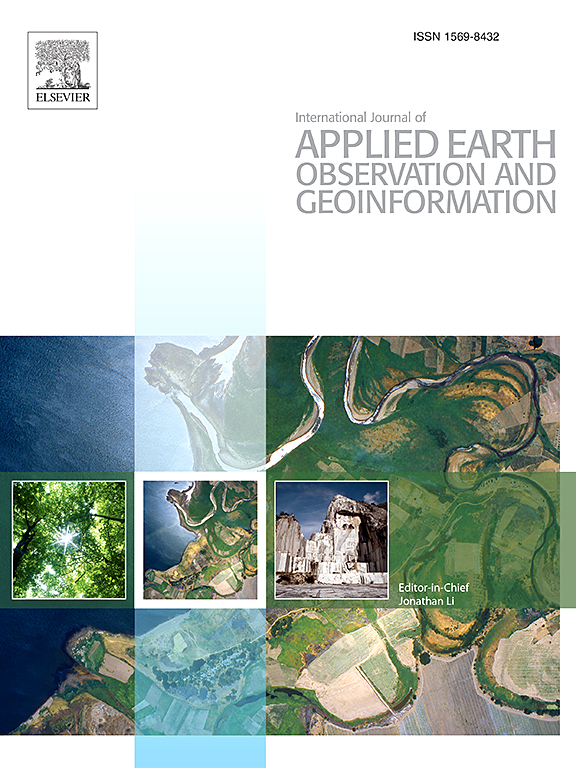Advancing coal fire detection model for large-scale areas based on RS indices and machine learning
IF 7.6
Q1 REMOTE SENSING
International journal of applied earth observation and geoinformation : ITC journal
Pub Date : 2025-05-22
DOI:10.1016/j.jag.2025.104587
引用次数: 0
Abstract
Coal fires present significant global environmental and energy challenges, posing substantial barriers to achieving carbon-neutral goals. Thermal Infrared Remote Sensing (TIRS) technology, which is used to retrieve land surface temperatures, plays a crucial role in detecting coal fires. However, its accuracy suffers from solar radiation interference. In addition, there is limited research focused specifically on detecting coal fires over large areas. In this paper, thermal anomaly indices (TAIs), derived from short-wave infrared and near-infrared data, were selected for coal fire detection due to their relatively low sensitivity to solar radiation. Using these TAIs alongside other remote sensing (RS) indices, a coal fire detection model (CFDM) was developed and trained using the AutoGluon machine learning (ML) framework. The model is capable of identifying large-scale coal fire target areas without relying on deformation associated with coal fires. CFDM outperformed other ML algorithms, achieving Recall, Precision, F1-score, and Kappa coefficient values of 0.89, 0.94, 0.93, and 0.92, respectively. Shapley Additive Explanations (SHAP) were used to evaluate the importance of different features, validating the model’s reliability and interoperability. The model’s robustness has been further demonstrated using observed coal fire points over Xinjiang, China, and Jharkhand, India. A T-test confirms that the proposed CFDM is significantly superior to TAIs-based methods, offering better differentiation of coal fires from other thermal anomalies and reducing commission errors.
基于RS指标和机器学习的大面积煤火探测模型的改进
燃煤给全球环境和能源带来了重大挑战,对实现碳中和目标构成了重大障碍。热红外遥感(TIRS)技术用于地表温度的反演,在煤火探测中起着至关重要的作用。然而,它的精度受到太阳辐射的干扰。此外,专门用于探测大面积煤火的研究也很有限。由于热异常指数对太阳辐射的敏感性相对较低,本文选择了来自短波红外和近红外数据的热异常指数(TAIs)进行煤火探测。利用这些tai和其他遥感(RS)指数,开发了一个煤火探测模型(CFDM),并使用AutoGluon机器学习(ML)框架进行了训练。该模型能够在不依赖与煤火相关的变形的情况下识别大范围的煤火目标区域。CFDM优于其他ML算法,Recall、Precision、F1-score和Kappa系数值分别为0.89、0.94、0.93和0.92。使用Shapley加性解释(SHAP)来评估不同特征的重要性,验证模型的可靠性和互操作性。在中国新疆和印度贾坎德邦观测到的煤火点进一步证明了该模型的稳健性。t检验证实,所提出的CFDM明显优于基于tai的方法,能够更好地区分煤火和其他热异常,并减少调试误差。
本文章由计算机程序翻译,如有差异,请以英文原文为准。
求助全文
约1分钟内获得全文
求助全文
来源期刊

International journal of applied earth observation and geoinformation : ITC journal
Global and Planetary Change, Management, Monitoring, Policy and Law, Earth-Surface Processes, Computers in Earth Sciences
CiteScore
12.00
自引率
0.00%
发文量
0
审稿时长
77 days
期刊介绍:
The International Journal of Applied Earth Observation and Geoinformation publishes original papers that utilize earth observation data for natural resource and environmental inventory and management. These data primarily originate from remote sensing platforms, including satellites and aircraft, supplemented by surface and subsurface measurements. Addressing natural resources such as forests, agricultural land, soils, and water, as well as environmental concerns like biodiversity, land degradation, and hazards, the journal explores conceptual and data-driven approaches. It covers geoinformation themes like capturing, databasing, visualization, interpretation, data quality, and spatial uncertainty.
 求助内容:
求助内容: 应助结果提醒方式:
应助结果提醒方式:


